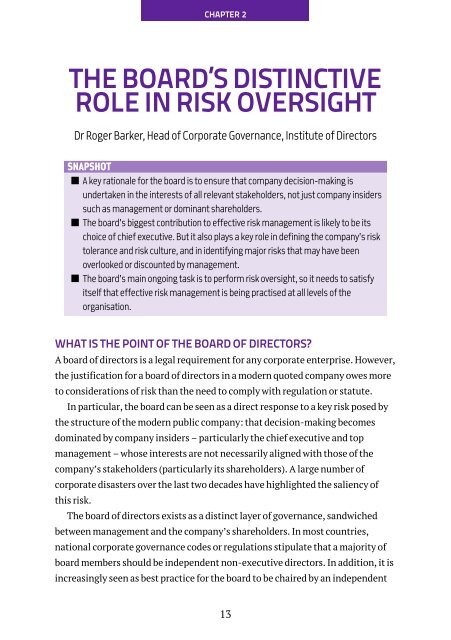Click here to download a pdf - Director Magazine
Click here to download a pdf - Director Magazine
Click here to download a pdf - Director Magazine
Create successful ePaper yourself
Turn your PDF publications into a flip-book with our unique Google optimized e-Paper software.
CHAPTER 2THE BOARD’S DISTINCTIVEROLE IN RISK OVERSIGHTDr Roger Barker, Head of Corporate Governance, Institute of Direc<strong>to</strong>rsSNAPSHOT■ A key rationale for the board is <strong>to</strong> ensure that company decision-making isundertaken in the interests of all relevant stakeholders, not just company insiderssuch as management or dominant shareholders.■ The board’s biggest contribution <strong>to</strong> effective risk management is likely <strong>to</strong> be itschoice of chief executive. But it also plays a key role in defining the company’s risk<strong>to</strong>lerance and risk culture, and in identifying major risks that may have beenoverlooked or discounted by management.■ The board’s main ongoing task is <strong>to</strong> perform risk oversight, so it needs <strong>to</strong> satisfyitself that effective risk management is being practised at all levels of theorganisation.WHAT IS THE POINT OF THE BOARD OF DIRECTORS?A board of direc<strong>to</strong>rs is a legal requirement for any corporate enterprise. However,the justification for a board of direc<strong>to</strong>rs in a modern quoted company owes more<strong>to</strong> considerations of risk than the need <strong>to</strong> comply with regulation or statute.In particular, the board can be seen as a direct response <strong>to</strong> a key risk posed bythe structure of the modern public company: that decision-making becomesdominated by company insiders – particularly the chief executive and <strong>to</strong>pmanagement – whose interests are not necessarily aligned with those of thecompany’s stakeholders (particularly its shareholders). A large number ofcorporate disasters over the last two decades have highlighted the saliency ofthis risk.The board of direc<strong>to</strong>rs exists as a distinct layer of governance, sandwichedbetween management and the company’s shareholders. In most countries,national corporate governance codes or regulations stipulate that a majority ofboard members should be independent non-executive direc<strong>to</strong>rs. In addition, it isincreasingly seen as best practice for the board <strong>to</strong> be chaired by an independent13









